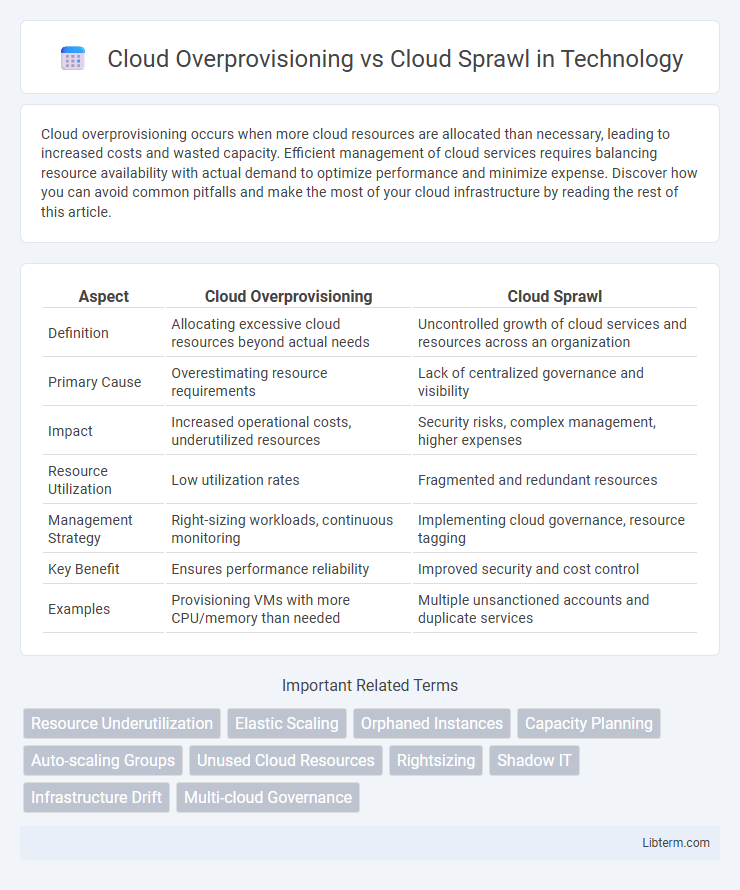Cloud overprovisioning occurs when more cloud resources are allocated than necessary, leading to increased costs and wasted capacity. Efficient management of cloud services requires balancing resource availability with actual demand to optimize performance and minimize expense. Discover how you can avoid common pitfalls and make the most of your cloud infrastructure by reading the rest of this article.
Table of Comparison
| Aspect | Cloud Overprovisioning | Cloud Sprawl |
|---|---|---|
| Definition | Allocating excessive cloud resources beyond actual needs | Uncontrolled growth of cloud services and resources across an organization |
| Primary Cause | Overestimating resource requirements | Lack of centralized governance and visibility |
| Impact | Increased operational costs, underutilized resources | Security risks, complex management, higher expenses |
| Resource Utilization | Low utilization rates | Fragmented and redundant resources |
| Management Strategy | Right-sizing workloads, continuous monitoring | Implementing cloud governance, resource tagging |
| Key Benefit | Ensures performance reliability | Improved security and cost control |
| Examples | Provisioning VMs with more CPU/memory than needed | Multiple unsanctioned accounts and duplicate services |
Understanding Cloud Overprovisioning
Cloud overprovisioning occurs when organizations allocate more cloud resources than necessary, leading to increased costs and underutilized infrastructure. This inefficiency contrasts with cloud sprawl, which describes the uncontrolled growth of cloud assets across multiple platforms and teams, complicating management and security. Properly understanding and managing cloud overprovisioning involves monitoring resource usage and rightsizing instances to optimize spending and performance.
Defining Cloud Sprawl
Cloud sprawl refers to the uncontrolled growth and proliferation of cloud resources across multiple platforms and accounts, leading to inefficient resource management and inflated costs. Unlike cloud overprovisioning, which involves allocating more cloud resources than necessary within a single environment, cloud sprawl results from decentralization and lack of governance over cloud deployments. Effective cloud management strategies focus on minimizing sprawl through centralized oversight and usage optimization.
Key Differences Between Overprovisioning and Sprawl
Cloud overprovisioning occurs when organizations allocate more cloud resources than needed, leading to increased costs and underutilized capacity. Cloud sprawl involves the unmanaged expansion of cloud services across multiple teams or departments, resulting in fragmented infrastructure and security risks. Key differences include overprovisioning being resource-centric inefficiency, while sprawl represents organizational management challenges and lack of governance.
Causes of Cloud Overprovisioning
Cloud overprovisioning occurs when organizations allocate more cloud resources than necessary, often driven by inaccurate demand forecasting and a desire to avoid performance bottlenecks during peak periods. This excessive allocation stems from unclear resource management policies, lack of monitoring tools, and a tendency to provision for worst-case scenarios without regular rightsizing. In contrast, cloud sprawl results from uncontrolled resource growth across multiple teams or projects, whereas overprovisioning specifically relates to oversized resource allocations within cloud services.
Triggers and Drivers of Cloud Sprawl
Cloud sprawl is primarily triggered by decentralized decision-making and the ease of provisioning cloud resources without centralized control, leading to uncontrolled growth in cloud assets. Key drivers include lack of governance policies, shadow IT practices, and inconsistent resource tagging, which complicate tracking and cost management. Overprovisioning contributes to sprawl by encouraging excessive resource allocation, but sprawl stems more from organizational and operational inefficiencies than just from excess capacity.
Impact on Cloud Costs and Budgets
Cloud overprovisioning leads to inflated cloud costs by allocating more resources than necessary, causing wasted expenditure on unused compute, storage, and networking capacity. Cloud sprawl results in fragmented and unmanaged cloud environments that further escalate costs due to duplicated services, orphaned instances, and lack of centralized budgeting controls. Both issues significantly strain cloud budgets, emphasizing the need for continuous monitoring, rightsizing, and governance to optimize cloud spend.
Risks to Security and Compliance
Cloud overprovisioning increases risks to security and compliance by creating excessive, unused resources that expand the attack surface and complicate governance. Cloud sprawl leads to fragmented environments with inconsistent security policies and insufficient visibility, resulting in higher vulnerability to breaches and non-compliance with industry regulations such as GDPR and HIPAA. Both conditions hinder effective monitoring, increase costs, and pose significant challenges to maintaining stringent access controls and audit requirements.
Strategies for Preventing Overprovisioning
Implementing automated resource monitoring and rightsizing tools can effectively prevent cloud overprovisioning by continuously adjusting instances based on actual usage patterns. Establishing clear cloud governance policies and enforcing quota limits helps control resource allocation, reducing the risk of unnecessary overprovisioned capacity. Integrating cost management platforms with predictive analytics provides insights for optimized capacity planning, minimizing waste while avoiding cloud sprawl.
Tools to Manage and Reduce Cloud Sprawl
Effective tools to manage and reduce cloud sprawl include cloud management platforms (CMPs) such as VMware vRealize, CloudHealth by VMware, and Microsoft Azure Cost Management. These platforms provide comprehensive visibility, governance, and automation capabilities to optimize cloud resource allocation and prevent overprovisioning. Integrating cost monitoring, automated tagging, and resource lifecycle management helps organizations maintain control over cloud usage and reduce unnecessary expenses.
Best Practices for Cloud Resource Optimization
Effective cloud resource optimization requires addressing both overprovisioning and cloud sprawl by regularly auditing resource usage and rightsizing instances based on actual demand metrics from tools like AWS Cost Explorer or Azure Advisor. Implementing strong governance policies with tagging strategies and automated lifecycle management helps prevent unmanaged resource growth and reduces unnecessary expenditure. Continuous monitoring and leveraging autoscaling features ensure resources scale dynamically, optimizing cost-efficiency and performance across cloud environments.
Cloud Overprovisioning Infographic

 libterm.com
libterm.com